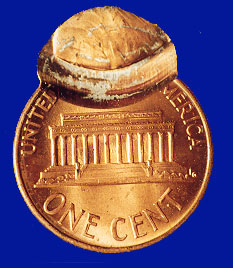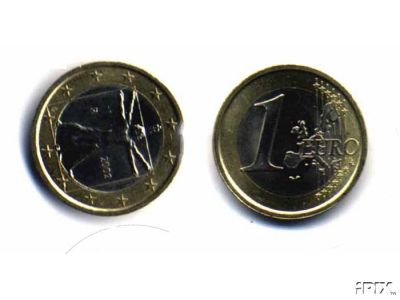 |
 |
 |
|||
 Varianti ed errori di conio Varianti ed errori di conio  |
|


Sovraconio La moneta viene coniata una seconda volta con le faccie girate. I flip over perfettamente centrati sono rarissimi. The
planchet is feed into the coinage press and rest inside the collar on
the anvil die (Reverse die). After being struck, the anvil die moves
upward, raising the coin. Now the coin is suppose to exit the coinage
press and go to a collecting area.
|
|
Conio
stanco Questo errore avviene quando si inizia a coniare le monete e il macchinario ha bisogno di aggiustare la forza di pressione del conio. Le prime monete coniate hanno un conio stanco, in genere l'operatore si occupa di distruggere queste monete ma qualche volta queste sfuggono alla vista. Die Adjustment Strikes are also known as die trials. This error occurs when a coin is struck from the press with very little pressure. When the press is being set up and adjusted, extremely weak strikes occur as the strike pressure reaches its optimum level. These die trials are destroyed after being struck and are rarely found in circulation.
|
|
Mulo Questo errore avviene quando inavvertitamente nella macchina vengono messi dondelli destinati a monete diverse, l'errore è assolutamente rarissimo e non può avvenire per monete di zecche diverse. Mule
|
|

Rotazioni Questo
errore avviene quando il conio ha una rotazione sul macchinario, in
pratica le due faccie della moneta non si trovano ad avere il corretto
allineamento. Rotated
Dies error is when the reverse die is not aligned properly with the
obverse die. This type of error can be easily identified by holding
a coin at the 3-o-clock position between your thumb and forefinger,
looking at the obverse design upright, and flipping in over vertically.
If the design on the reverse isn't upright (looks rotated either clock-wise
or counter clock-wise), you've found a rotated-dies error.
|
|
Il mezzo contorno avviene quando il collare non avvolge completamente il tondello durante il conio, in questo caso la moneta avrà il contorno formato soltanto per metà (o parte di esso) Partial
collar strikes occur when there is a malfunction of the striking press.
This causes the collar to be in an incorrect position. The lower die
(usually the reverse die) is recessed in the collar. This allows the
coin which is going to be struck to have a formed rim. After a coin
is struck the lower die raises upwards, pushing the struck coin out
of the collar and ejecting it. |
|
|
Questa classificazione potrebbe non rispecchiare la vostra idea di classificazione degli errori, se avete proposte variazioni sul tema aggiunte non esitate a contattarmi che ne discuteremo. |
| Se sei interessato a conoscere alcuni spettacolari errori dell'Euro consulta: |
| www.attilacoins.com |
| sito di Attila membro di Grandoblone. |
|
|
|
|
Nella
sezione sottostante cercheremo di rispondere a tutte le vostre domande
|
|
|
Scrivete
le vostre domande a info@attilacoins.com
|
|
| Domanda | |
| Risposta |